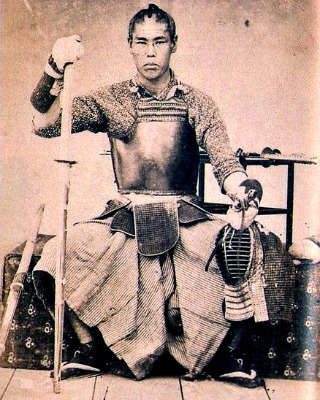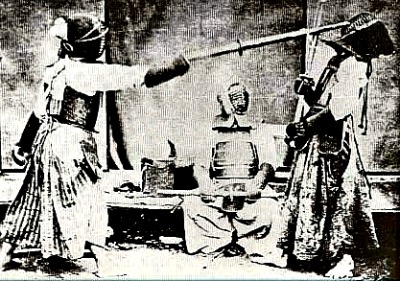The History of Kendo
What is Kendo?
Kendo is a form of Japanese sword fighting developed from the samurai art of kenjutsu.
Two opponents face each other and score points by hitting specific
target areas on their opponent’s body with a replica sword made out of bamboo called a shinai.
While kendo is mostly practised as a sport today, it also teaches the
deadlier traditional sword techniques of the samurai within the kata and is designed to help develop personal growth and character in its practitioners (known as kendoka).
Talk the Talk
The word kendo can be split into two parts, ken, meaning sword and do, meaning the way or path.
Therefore, kendo is translated to mean the Way of the Sword. The forbearer of kendo is the Japanese sword fighting discipline that was practised by the samurai known
as Kenjutsu, which literally means Sword Technique.

Kendo history has its roots in the Heian Period (794 – 1185) of Japan and around 940 CE, specific sword fighting techniques began to be designed and taught to soldiers. These moves were developed and perfected over the coming centuries both on and off the battlefield by the samurai as they would be used in war and in private duals.
The Development of Kenjutsu
With the onset of the Edo Period (1603 – 1868) the country saw a prolonged era of civil peace meaning there was no longer the opportunity for samurai warriors to hone their skills on the battlefield.
Martial arts schools began opening all over Japan in order to preserve the techniques used in warfare and to cultivate discipline and self-growth in participants. These included jiu-jitsu schools that were dedicated to the practice and preservation of the hand-to-hand fighting techniques of the samurai and kenjutsu schools who trained in the sword techniques of their forbearers.
In the eighteenth century, it is believed that the father and son duo of Yamada Heizaemon Mitsunori and Naganuma Shirozaemon Kunisato of the Jiki-shinkage school developed the lightweight armour known as bogu and the wooden practice sword known as the shinai. This was deemed necessary to allow realistic fencing training while minimising the risk of injury, which were commonplace when using real swords or the traditional wooden training sword known as the bokken.
Both the bogu and the shinai were improved and refined in the early nineteenth century, and the period also saw some degree of systemisation within kenjutsu. Three schools, the Genbukan led by Chiba Shusaku, the Renpeikan led by Saito Yakuro and the Shigakkan led by Momoi Shunzo, collectively known as the Three Great Dojos of Edo, became very popular.
Chiba Shusaku was particularly influential on the modern art of kendo as in the 1820s, he introduced gekiken (hitting sword), full contact fights with shinai and bogu using what became known as the Sixty-Eight Techniques of Kenjutsu, some of which are still used by kendoka today.
With the start of the Meiji Restoration in 1868 and the return of Imperial rule in Japan, samurai culture was mostly outlawed including a ban on carrying weapons. Now, only the state police were allowed to carry swords in public and the practice of martial arts went into decline. However, in 1895, the Dai-Nippon Butoku-Kai was established to help promote and preserve the martial arts of the samurai, including the sword techniques collectively known as kenjutsu.
The History of Kendo as a Sport
Sakakibara Kenkichi popularised gekiken kogyo from 1873, whereby martial artists would demonstrate their skills with the sword by putting on public demonstrations. The first of these took place in Asakusa and was a ten-day event that could be watched by anyone for a small fee; spectators could even participate if they had the skills or were brave enough to try. While these events were often seen as too showy and extravagant for some hard-line traditional martial artists, they did succeed in generating much interest in the sport side of Japanese sword fighting and played a large part in the revival of the martial arts in the country.
By 1912, the name kendo began to be used with the Dai-Nippon Butoku-Kai officially changing the name from gekiken to kendo in 1920. Soon after, kendo kata were developed from older forms from kenjutsu in a bid to better preserve the techniques and by 1936, most schools were teaching a formalised version of the art of kendo.
After World War Two, martial arts were banned for a time in Japan but the All Japan Kendo Federation was established in 1952 bring about renewed interest in the art in the county. From this point in kendo history, it was being taught much more as an educational sport than a martial art as it usually is to this day (though many of the deadlier moves are preserved within the kata much like they are in other popular martial arts in Japan such as karate and judo).
Modern sports kendo involves two opposing fighters trying to strike specific areas on their opponent’s body with a shinai. The competitors are still protected by the bogu, which consists of:
- The Uwagi (jacket)
- The Hakama (long divided skirt)
- Do (chest protector)
- Tare (waist protector)
- Men (head piece)
- Kote (padded gloves)
The shinai varies from 43 to 46 inches (110 to 118 cm) in length and usually requires a two-handed grip to be used effectively. Striking attacks can be directed at the head, torso, wrists and forearms, along with thrusting attacks usually aimed at the throat. However, it is not enough just to hit the target in order to score, the technique must be executed correctly with a strong kiai (shout) demonstrating good spirit and with the use of zanshin (awareness). The winner is decided when one of the fighters reaches two points.
The Art of Kendo
More than just a sport or style of fighting, the art of kendo is a way to build character and takes great perseverance, alertness and concentration to master and execute the moves. A kendo practitioner also needs to conquer his own fears and be able to perform the techniques in any situation. To do this, kendo uses Zen Buddhist meditation in order to learn to gain a mental state known as Mushin (mind without mind). This conscious state of being totally aware but without having a constant flow of thoughts allows for quicker reaction times and usually better and more decisive decision making.
Kendo history was further advanced in 1970 with the creation of the International Kendo Federation to accommodate the growing number of kendoka practicing outside of Japan. Today, millions of people from all over the world study the art and the number of participants overseas continues to grow. In 2015, the sixteenth triennial World Kendo Championships was held in Tokyo, Japan and was host to kendoka from fifty-six countries and regions from across the globe.
Written by Andrew Griffiths – Last updated 24/06/2023. If you like
what you see, consider following the History of Fighting on social media.
Further Reading:
Amazing Use of Bamboo Swords in Kendo. [Internet]. 2018. C N Kendo. Available from: http://www.cnkendo-da.com/2017/10/03/amazing-use-of-bamboo-swords-in-kendo [Accessed July 30, 2018].
History of Kendo. [Internet]. 2018. Kendo.com. Available from: http://kendo.com/history [Accessed July 30, 2018].
History of kendo. [Internet]. 2018. University of California, Los Angeles. Available from: http://classes.design.ucla.edu/si/07/web/week2/kevin/assignment%202/page2.html [Accessed July 30, 2018].
Kendo. [Internet]. 1998. Britannica. Available from: https://www.britannica.com/sports/kendo [Accessed July 30, 2018].
Kendo History. [Internet]. 2018. University of Southern California. Available from: http://scf.usc.edu/~jialouwa/itp104/final/kendohistory.html [Accessed July 30, 2018].
Philosophy of Kendo. [Internet]. 2018. University of Chicago. Available from: http://kendo.uchicago.edu/aboutkendo.html [Accessed July 30, 2018].
The images on this site are believed to be in the public domain, however, if any mistakes have been made and your copyright or intellectual rights have been breeched, please contact andrew@articlesonhistory.com.

